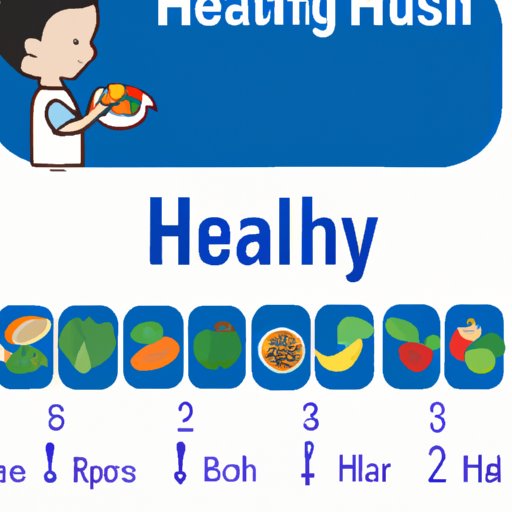Introduction
Eating healthy is an important part of a healthy lifestyle. It is not only important for physical health, but also mental and emotional health. But what does it mean to eat healthy? Eating healthy is about eating a variety of nutrient-dense foods in the right amounts. This means getting the right balance of nutrients from fruits and vegetables, whole grains, lean proteins, and healthy fats.
There are numerous benefits to eating healthy, including improved energy levels, better digestion, weight loss, and improved mood. Eating healthy can also reduce the risk of chronic diseases such as diabetes, heart disease, and cancer.
Healthy Eating Habits
Creating healthy eating habits requires understanding nutrition, incorporating nutrition into your life, and making informed choices about food. Understanding nutrition involves learning about the different food groups, how much of each group you need, and the importance of vitamins and minerals. Incorporating nutrition into your life means taking the time to plan meals and snacks that include a variety of nutrient-rich foods. Lastly, making informed choices about food means reading labels and being aware of the nutritional content of the foods you eat.
“Good nutrition is key to overall health and wellbeing,” says Dr. Sarah Samaan, cardiologist and weight management expert at Baylor Scott & White Legacy Heart Center. “The human body needs certain essential nutrients to remain healthy and function optimally. Eating a balanced diet ensures that we get all of these nutrients in the right amounts.”
The Basics of Eating Healthy
Eating healthy starts with understanding the basics of nutrition. The five main food groups are fruits, vegetables, grains, proteins, and dairy. Each group provides different vitamins, minerals, and other nutrients needed by the body. It is important to understand which foods belong to each group, how much of each group you need, and the importance of vitamins and minerals.
In addition to understanding the food groups, it is important to understand portion sizes. Portion sizes refer to the amount of food eaten at one time. For example, a serving size of protein is 3 ounces (or the size of a deck of cards). Eating too much or too little of any food group can lead to nutritional deficiencies or weight gain.
It is also important to understand the different types of nutrients found in food. Nutrients are substances found in food that provide energy and help the body to function properly. These include carbohydrates, proteins, fats, vitamins, and minerals. Eating a variety of foods from each food group will ensure that you get all the essential nutrients your body needs.
Finally, it is important to choose healthy foods. Healthy foods are those that are minimally processed and contain fewer additives and preservatives. Examples include fresh fruits and vegetables, whole grains, lean meats, and low-fat dairy. Unhealthy foods are those that are highly processed and contain added sugars, saturated fats, and sodium.

Eating Healthy on a Budget
Eating healthy doesn’t have to be expensive. There are several ways to save money while still eating nutritious meals. Planning ahead is one of the best ways to save money. Meal planning helps you make the most of your grocery budget by ensuring that you buy only what you need. Shopping with a list also helps to keep costs down. Another way to save money is to buy in bulk when possible. Buying in bulk allows you to buy larger quantities of items for less.
Stocking up on healthy food is another way to save money. Stocking up on frozen fruits and vegetables, canned beans and lentils, whole grains, and shelf-stable milk is a great way to ensure that you always have nutritious options on hand. Canned and frozen produce are often cheaper than fresh and just as nutritious.
Eating Healthy for Kids
Raising healthy eaters can be challenging, but it is worth the effort. Teaching children about nutrition and encouraging healthy eating habits is an important part of helping them make healthy choices. Start by modeling healthy eating habits yourself. Pack healthy lunches and snacks and serve nutritious meals. Provide plenty of fruits and vegetables and limit processed and sugary foods.
It is also important to involve children in meal planning and preparation. Letting them pick out their own fruits and vegetables at the store, helping to prepare meals, and setting the table are all great ways to get them involved. Finally, be sure to talk to your children about healthy eating. Explain why certain foods are good for them and how they can help them feel their best.
Conclusion
Eating healthy is essential for overall health and wellbeing. It is important to understand nutrition, incorporate nutrition into your life, and make informed choices about food. Eating healthy provides numerous benefits, including improved energy levels, better digestion, weight loss, and improved mood. Eating healthy on a budget is possible with careful planning and stocking up on healthy foods. Finally, teaching children about nutrition and involving them in meal planning and preparation is important for raising healthy eaters.
By following these tips and incorporating healthy eating habits into your life, you can enjoy the many benefits of eating healthy and live a healthier life.
(Note: Is this article not meeting your expectations? Do you have knowledge or insights to share? Unlock new opportunities and expand your reach by joining our authors team. Click Registration to join us and share your expertise with our readers.)
